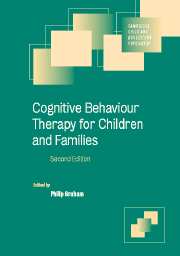Book contents
- Frontmatter
- Contents
- List of contributors
- 1 Introduction
- Part I Developmental cognitive theory and clinical practice
- Part II Engagement and assessment
- Part III Client groups
- 7 Working with parents: some ethical and practical issues
- 8 Cognitive behaviour therapy with prepubertal children
- 9 Cognitive behaviour therapy in inpatient environments
- Part IV Applications in psychosocial adversity
- Part V Applications in specific child and adolescent psychiatric disorders
- Part VI CBT applications in preventive interventions
- Index
- References
9 - Cognitive behaviour therapy in inpatient environments
Published online by Cambridge University Press: 21 August 2009
- Frontmatter
- Contents
- List of contributors
- 1 Introduction
- Part I Developmental cognitive theory and clinical practice
- Part II Engagement and assessment
- Part III Client groups
- 7 Working with parents: some ethical and practical issues
- 8 Cognitive behaviour therapy with prepubertal children
- 9 Cognitive behaviour therapy in inpatient environments
- Part IV Applications in psychosocial adversity
- Part V Applications in specific child and adolescent psychiatric disorders
- Part VI CBT applications in preventive interventions
- Index
- References
Summary
Introduction
Children and adolescents treated within inpatient child and adolescent psychiatry units form a heterogeneous population in terms of age, functional difficulties and diagnosis. Adaptation of cognitive behaviour therapy (CBT) for use within these units therefore needs to take into account their varied characteristics. It also needs to consider the particular features of an inpatient unit as a treatment environment. Consequently, this chapter will begin by reviewing each of these two areas – the patient group and the treatment environment – before going on to consider the role of CBT as a treatment within the inpatient setting.
Characteristics of child and adolescent inpatients
Diagnostic pattern
Recent national UK survey data (O'Herlihy et al., 2001) have provided a comprehensive cross-sectional picture of the current diagnostic composition of inpatient practice in the UK (Table 9.1). Surveys from other countries have shown similar patterns of morbidity (Sourander and Turunen, 1999).
The census reflects some key diagnostic patterns in inpatient populations:
Eating disorders represent a high percentage of female admissions in both child and adolescent groups.
Acute psychosis is an important cause of admission in adolescence but is not at all negligible in children.
Despite often being thought of as contraindications for admission, conduct disorder and other externalizing problems are highly prevalent in child admissions, especially in younger boys.
Pervasive developmental disorders and other neuropsychiatric conditions are most common in child units.
Mood disorders are an important component of both adolescent and child populations.
Functional impairment
Diagnosis alone, however, is not the main predictor of outcome or need in this population (Green et al., 2001; Green, 2002).
- Type
- Chapter
- Information
- Cognitive Behaviour Therapy for Children and Families , pp. 136 - 154Publisher: Cambridge University PressPrint publication year: 2004



